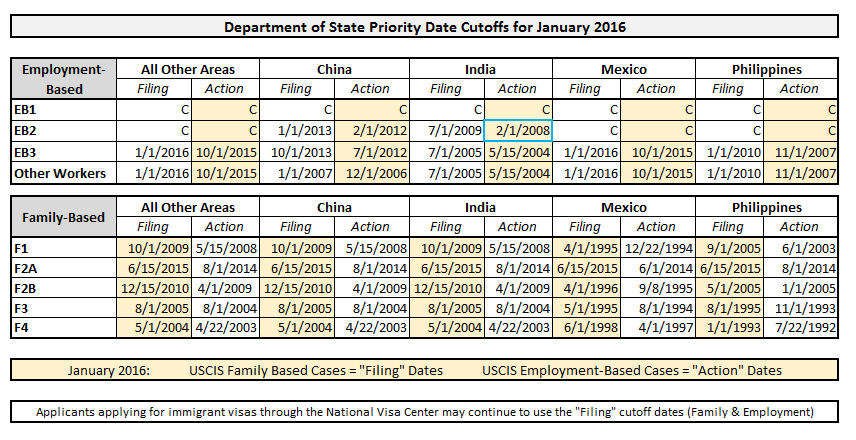January Visa Bulletin
December 22, 2015
The Department of State has released the January update to the Visa Bulletin. Meanwhile, USCIS will continue to keep people guessing every month as to which set of priority dates will be in effect.
Application Final Action Dates vs. Dates for Filing Visa Applications
In September, the Department of State surprised everyone by announcing that there would be two different priority date charts going forward. The ‘old’ priority date chart would continue on as the “Final Action” chart, and would be used to indicate when an actual visa number is available, allowing final adjudication of a permanent residence application. In addition, they introduced a new “Dates for Filing” chart, which had priority date cutoffs ranging from a few weeks to a few years earlier than those found on the Final Action chart. This would allow people stuck in a long line to submit applications a bit sooner, meaning they would have earlier access to AC21 portability and would be able to submit EAD/AP applications earlier.
But at the very last minute, the Department of State announced major changes to the “Dates for Filing” chart, revising some dates backwards by years.
In October, USCIS (which is part of the Department of Homeland Security – a completely different branch of government from the Department of State) announced that they would be choosing on a month-by-month basis which set of cutoff dates would be used to determine filing eligibility. In that first month, all categories were permitted to use the “Dates for Filing” chart, giving hope that USCIS would only opt for the “Final Action” chart as a last resort, when visa numbers had run out. According to a note in the just-released January visa bulletin, the exact opposite is the case:
Unless otherwise indicated on the USCIS website atwww.uscis.gov/visabulletininfo, individuals seeking to file applications for adjustment of status with U.S. Citizenship and Immigration Services (USCIS) in the Department of Homeland Security must use the “Application Final Action Dates” charts below for determining when they can file such applications. When USCIS determines that there are more immigrant visas available for the fiscal year than there are known applicants for such visas, USCIS will state on its website that applicants may instead use the “Dates for Filing Visa Applications” charts in this Bulletin. Applicants for adjustment of status may refer to USCIS for additional information by visitingwww.uscis.gov/visabulletininfo.
USCIS’s January Decision
USCIS has indicated that in January – as in December – family-based applications will be accepted according to the “filing” dates, while employment-based cases will be accepted based on the older, slower-moving “final action” cutoff dates.
Priority Dates
Many “Filing” dates in the family-based categories advanced 3-6 months. Final Action dates advanced more slowly (or not at all) across all categories, expect India EB-2, which has now advanced 18 months since the November Visa bulletin. There were no retrogressions this month. The complete chart is below (click to enlarge).
July 6, 2025
Federal Judge Blocks Early End to TPS for Haitian Nationals On Tuesday, July 1, 2025, District Court Judge Brian M. Cogan in New York ruled that it was unlawful to...MoreJune 16, 2025
Department of State Releases July 2025 Visa Bulletin The DOS released its July 2025 Visa Bulletin. For July 2025, USCIS determined that for all family-sponsored preference categories, you...More




